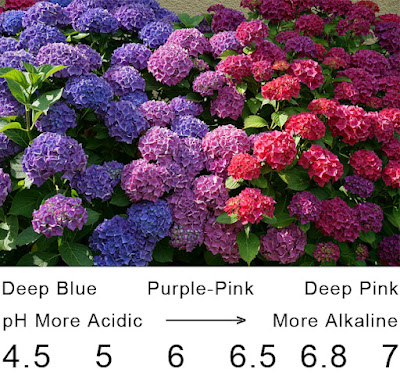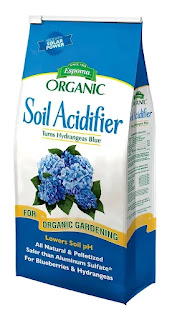What makes hydrangea flowers susceptible to color differentiation is variation in the pH of the soil it's rooted in. The pH level is what determines how much aluminum the plant will take in, in turn affecting the color that is expressed. When soil has been found to be more acidic (lower pH), the flower color appears closer to blue. Whereas when the soil is more alkaline (higher pH), the flower color appears closer to pink. The values in between those numbers produce purple flowers with a hue closer to pink or blue depending on if its a higher or lower pH. It is also possible to see a combination of pink and blue flowers existing on a single plant at the same time. This is possible when the roots supporting a given number of stems of one plant are grown in soils with differing pH. Furthermore, some flowers of this plant species only produce white or light green petals regardless of the soil's pH.
 |
| Visual taken from an article shows the range of flower color in relation to pH levels numbered on a scale from more acidic to more alkaline. |
In addition to natural change in soil pH that causes these flowers to change color, people have been able to manipulate how acidic/alkaline the soil is through a selective breeding process of artificial selection. Artificial selection is defined as the identification by humans of desirable traits in plants and animals, and the steps taken to enhance and perpetuate those traits in future generations.
When eighteenth-century gardeners first noticed that hydrangeas could change colors, they experimented in various ways to find out what it was that was controlling this change. These experiments included burying rusty nails, pouring tea, or even chanting spells around their plants. Now however, we are aware of the factor that controls this phenotypic change and people today control it by simply altering the pH of soil through soil additives that work to adjust the amount of aluminum present. Although this may sound like a quick process, these color changes happen to take around one to two growing seasons, and require regular watering with specific amounts of additive to be successful.
To understand why this works, it's necessary to think at a more molecular level. In acidic soil, aluminum ions are mobile due to other readily available ions that they can react with. In this case, aluminum occurs in coordination complexes, with its ions at the center surrounded by bonded strings of other molecules, allowing the ions to migrate from the soil up into the hydrangea's bloom. In neutral to basic (alkaline) soil however, the ions combine with hydroxide ions to form immobile aluminum hydroxide, which does not get taken up by the plant. Accordingly, in order for a hydrangea to change color from pink to blue, both aluminum ions and acidic soil are needed, which can be implemented by adding aluminum sulfate. On the other hand, to change color from blue to pink, adding lime (calcium hydroxide) is what results in the necessary basic soil.
The composition of hydrangeas are further unique in that their colors come from just one pigment, rather than several as in most flowers that can produce different colors. This sole pigment is known as delphinidin-3-glucoside, and comes from the anthocyanin family (the same group that turns leaves red in autumn). The color of the pigment, is a function of its molecular structure, which determines what wavelengths of lights are absorbed. The structure of these molecules consist of a central three-ring carbon chain with one oxygen substitution, called a flavylium cation at low pH, where various sugars are connected. As the environmental pH changes, the anthocyanin pigment loses one or more hydrogen ions, which causes change to its absorbance spectra.
 |
| Image of soil additive product sold by Gardener's Supply Company |
 |
| Image of blue Hydrangea macrophylla plant |
Now, although I have been referring to these extraordinary plants as flowers, most of the ones we see today are actually flowerless. This was pretty surprising to me, as I had not been aware of the fact and thought what I'm sure most of you reading are thinking, "How could plants that appear exactly as flowers not be flowers?" Well, this is because of a lack of reproductive parts. These appealing hydrangeas are merely sterile clusters of colorful 'petals', which for correct terminology, are really sepals. Without the reproductive parts of a flower, there is no pollen or nectar made available for pollinators, and this inhibits natural form of plant reproduction. This is why you won't regularly see bees attracted to these plants!
There are however, several other hydrangea species that are fertile and attract bees frequently. In the scientific tree of life, Hydrangea is classified as a genus with over 75 species of flowering plants. The wide variety of these plants are found native to Asia and the Americas. As the primary focus of this post, the most common specie of Hydrangea are Hydrangea macrophylla, which are also referred to as big leaf hydrangeas, mophead hydrangeas, and hortensia. Plants that share the scientific name, but have fertile flowers, are usually known as lacecaps. These types of hydrangeas can come in many beautiful varieties and have the added benefit of being great for pollinators. They grow with similar sepals as the mopheads, but instead of their sepals being all clustered together, they are spread out around clusters of tiny, fragrant, fertile buds.



One of my favorite plants! Also the part about people chanting around their hydrangeas made me laugh:)
ReplyDelete